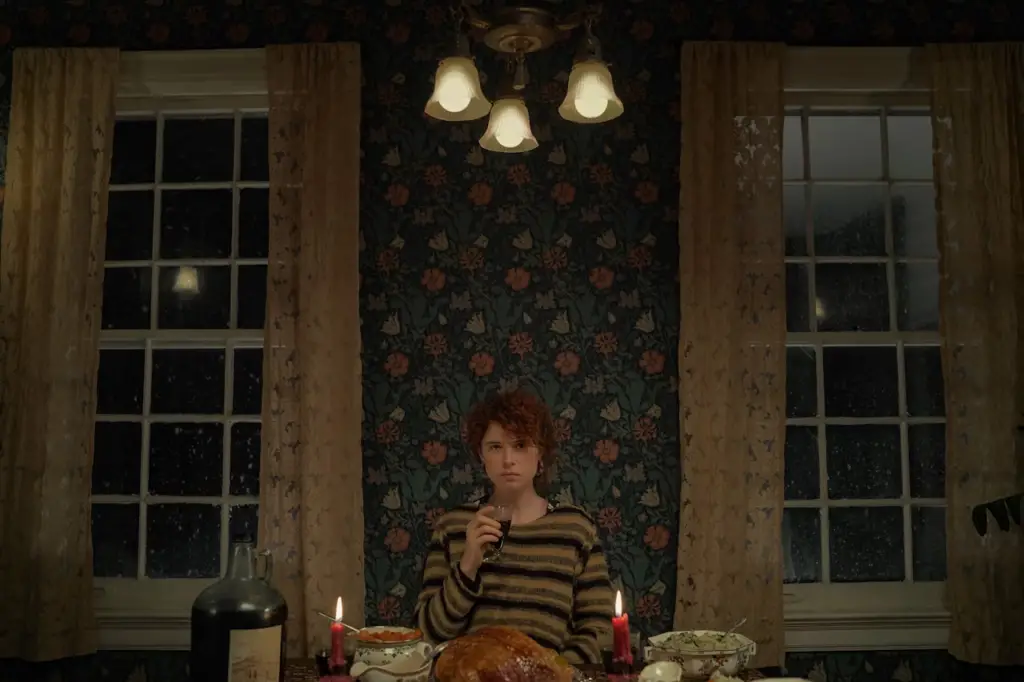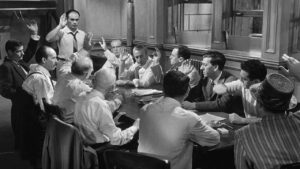Table of Contents
Introduction: The Complexity of Choices
“I’m Thinking of Ending Things” is a film that challenges viewers to confront their understanding of identity, reality, and the emotional intricacies of relationships. Directed by Charlie Kaufman, the movie weaves a complex narrative that captures the essence of indecision and inner turmoil, leaving audiences asking, “What does it all mean?”
In this blog post, we aim to unravel the film’s profound themes and ideas. By exploring psychological concepts and philosophical inquiries, we will provide a comprehensive analysis of the film. Our focus will be on how these elements contribute to an overall understanding of the narrative and its characters.
As we delve into the intricate layers of “I’m Thinking of Ending Things,” we’ll ultimately seek to answer the question of meaning that emerges from its often bewildering plot. Join us as we embark on this journey to better comprehend the core of the film.

Understanding Identity: The Masks We Wear
The Duality of Self
In “I’m Thinking of Ending Things,” the exploration of identity is a central theme. The characters grapple with their true selves versus the personas they present to the world. This duality is evident in the protagonist’s internal monologue as she reflects on her relationship and the different roles she takes on. The film masterfully highlights how people often wear masks, altering their identities to fit expectations or to avoid facing uncomfortable truths.
As the story unfolds, it becomes clear that these masks serve as both a shield and a prison. They protect individuals from vulnerability but simultaneously alienate them from their authentic selves. This tension amplifies the psychological complexity of the film, forcing viewers to ponder the nature of identity itself.
Perception vs. Reality
Another compelling aspect of the film is how it delves into the distinction between perception and reality. The characters’ perceptions of one another are steeped in their assumptions and biases. The protagonist often perceives her boyfriend through a lens colored by doubt and unease, leading to an evolving understanding of who he truly is—or perhaps who she believes him to be. This distortion creates a rift between their actual identities and the versions they choose to portray.
The film subtly invites the audience to consider how individuals’ self-conceptions can differ drastically from how they are perceived by others. This discrepancy evokes questions about authenticity and the existential weight of maintaining appearances in a society that pressures individuals to conform. The film becomes a mirror, reflecting back on the audience’s own experiences with identity.
The Influence of Relationships
Relationships profoundly shape our identities, as seen in the dynamics between the protagonist and her boyfriend. Their interactions reveal how identities can be influenced or manipulated by emotional connections. The protagonist’s internal conflict over her feelings mirrors the complexity of understanding oneself in the context of another person.
In this light, “I’m Thinking of Ending Things” forces audiences to confront the unsettling notion that our identities are not entirely our own. Instead, they are often constructed in relation to those we are closest to, leading to an ongoing negotiation between authenticity and the desire for acceptance. The film’s exploration of these themes provides fertile ground for reflection on the masks we wear and the identities we curate in our lives.

The Nature of Reality: Perception vs. Truth
The Subjectivity of Experience
In “I’m Thinking of Ending Things,” the distinction between perception and truth emerges as a critical theme. The film artfully illustrates how reality can be subjective, deeply influenced by individual experiences and emotional states. The protagonist’s journey is laden with moments of doubt and confusion, as her perception of events often diverges sharply from the objective reality around her.
As viewers are drawn into her internal struggles, it becomes clear that the lens through which she views the world is colored by anxiety and existential questioning. This highlights a fundamental philosophical inquiry: is our understanding of reality shaped more by our thoughts and feelings than by the concrete world itself? The film encourages us to consider how personal experiences can distort our grasp of truth, leaving us in a state of perpetual ambiguity.

The Role of Memory
Memory plays a key role in shaping perceptions of reality throughout the film. The protagonist’s recollections fluctuate, merging moments of the past with the present, creating a disorienting narrative that blurs the lines between what truly happened and what might be mere constructs of her mind. This interplay between memory and reality emphasizes how our past experiences inform our current understanding of ourselves and those around us.
Kaufman’s narrative technique invites the audience to reflect on the fallibility of memory, raising questions about how memories can be shaped by time, emotion, and context. The tension between what is remembered and what is factual contributes to the emotional weight of the characters’ interactions, illustrating the complexity of human experience.
The Unraveling of Truth
As the story progresses, the protagonist’s perception begins to unravel, leading to a deeper exploration of what constitutes truth. The film illustrates how an individual’s understanding of reality can disintegrate under the weight of self-doubt and conflicting emotions. The gradual revelation of the protagonist’s inner thoughts acts as a commentary on the nature of truth itself—can it ever be fully grasped when filtered through a mind in turmoil?
The film’s ambiguous ending leaves viewers grappling with the implications of its themes. Are we left with a sense of truth, or does the narrative affirm that reality is ultimately fluid, shaped by our perceptions? By examining the nature of reality, “I’m Thinking of Ending Things” challenges audiences to reconsider their own understandings of truth in the face of subjective experience, inviting introspection about the ways in which perception can both illuminate and obscure our grasp of reality.
The Weight of Regret: Psychological Implications
The Paralysis of Indecision
“I’m Thinking of Ending Things” intricately weaves a narrative that captures the heavy influence of regret on the human psyche. The film delves into the protagonist’s struggle with indecision, illustrating how the burden of potential choices can lead to psychological paralysis. The overwhelming thought of what could have been—or what one might lose—creates a mental landscape filled with doubt and anxiety.
Regret is often defined as the emotional response to perceived wrongdoings or decisions that could have yielded better outcomes. The protagonist grapples with her thoughts as she contemplates her feelings toward her boyfriend, embodying the weight of her indecision. This emotional turmoil offers a poignant reflection on how the anticipation of regret can inhibit one’s ability to act freely and authentically, leading to a sense of entrapment in one’s own mind.

The Echoes of Past Choices
As the narrative unfolds, the film encapsulates how past choices resonate in the present, shaping the characters’ realities. The protagonist’s reflections reveal that feelings of regret are not merely momentary; they linger, haunting individuals and influencing their future actions. This motif underscores a critical psychological truth: individuals often relive their past mistakes in their minds, allowing those echoes to shape their current perceptions and relationships.
The film poignantly illustrates how regret can cultivate a sense of hopelessness, particularly when individuals feel trapped by their decisions. The protagonist’s internal dialogue serves as a reminder that these feelings are universal, afflicting everyone at various points in life. By portraying regret in such a raw and honest manner, Kaufman invites viewers to confront their own experiences with past choices and the emotional weight they carry.
The Alleviation of Regret
Amidst this exploration of regret, “I’m Thinking of Ending Things” also suggests paths toward alleviating its burden. The film contemplates the possibility of acceptance and understanding as means of coping with past decisions. Through the protagonist’s journey, viewers witness her attempts to wrestle with her emotions and the difficult truths of her relationships, which ultimately leads to pivotal moments of self-discovery.
The journey toward acceptance highlights that while regret may be an inevitable part of the human experience, it does not have to paralyze or define individuals. Embracing the complexities of life, acknowledging imperfections, and allowing oneself to be vulnerable can pave the way for healing. By examining the psychological implications of regret, the film offers a rich tapestry of insights into the intricacies of human emotion, ultimately encouraging audiences to reflect on their own weights and the potential for liberation from the shackles of their past.
Ending Explained: Decoding the Finale
The Final Moments of Reflection
The ending of “I’m Thinking of Ending Things” is both enigmatic and profound, serving as a culmination of the themes woven throughout the film. As the narrative reaches its climax, viewers are presented with a surreal sequence that invites contemplation on the nature of existence, identity, and the passage of time. The protagonist’s experience in the car, alongside her boyfriend, transitions into a series of hallucinatory moments that blur the boundaries between past, present, and future.
In these final moments, the protagonist appears to confront not only her relationship but also her own existence. The imagery and dialogue reflect her internal struggle, hinting at the culmination of her regret and the weight of her indecision. It becomes evident that her journey is marked by a profound desire to escape the confines of her present reality—a reality that feels increasingly suffocating as it is colored by her experiences and choices.

The Significance of the School and the Monologue
A key scene that elicits much interpretation is set within a seemingly abandoned school. Here, the protagonist watches a production of a play that seems to correlate with her own experiences from earlier in the movie. This intermingling of narrative layers suggests a deeper psychological commentary on her fears and desires. The school symbolizes a place of learning, but also nostalgia and unresolved emotions, serving as a transformative backdrop for her climactic self-realization.
The monologue delivered by the janitor encapsulates themes of regret, aging, and the nature of choices. When viewed through the lens of the protagonist’s journey, it serves as a poignant reminder of the inevitability of time and the importance of acting on one’s desires before it is too late. This reflection on mortality, together with the abandonment of youthful aspirations, enhances the film’s exploration of existential truths—how we grapple with the past while inevitably moving toward the future.
The Leap of Understanding
As the narrative weaves through layers of symbolism and introspection, the ending ultimately presents a leap of understanding for the protagonist. It becomes a moment of acceptance, as she appears to embrace her own truths, however painful they may be. Viewers are left with the impression that the protagonist’s journey has led her to confront the core of her identity, allowing for the possibility of liberation from her burdensome regrets.
In this way, the ending can be interpreted as an invitation for audiences to reflect on their own experiences with identity, regret, and the pursuit of authenticity. By decoding the finale of “I’m Thinking of Ending Things,” viewers can appreciate the psychological depth of the film, recognizing that personal journeys often culminate in moments of profound realization and transformative acceptance.
Visual and Narrative Techniques: Crafting the Experience
Cinematic Framing and Composition
One of the most striking aspects of “I’m Thinking of Ending Things” is its meticulous visual style. Charlie Kaufman employs distinctive framing and composition to enhance the psychological landscape of the story. The use of tight shots creates a sense of claustrophobia, mirroring the protagonist’s feelings of being trapped within her own indecision and regrets. Throughout the film, her facial expressions and body language convey an internal struggle that resonates deeply with viewers, revealing the complexity of her emotions.
Color plays a pivotal role in establishing mood, with the muted and cold tones reflecting the somber and haunting atmosphere that permeates the narrative. The contrasting warmth of moments that evoke nostalgia underscores the protagonist’s longing for clarity and connection. Kaufman’s ability to blend visuals with psychological themes enhances the overall experience, drawing audiences into the emotional world of the characters.

Nonlinear Storytelling
Another hallmark of the film is its nonlinear storytelling structure. The narrative weaves between fragmented memories, conversations, and dreamlike sequences, challenging viewers to piece together the protagonist’s internal journey. This disjointed approach cleverly mirrors the chaotic nature of human thought and experience, as well as the struggles individuals face when reflecting on identity and the past.
The dialogue often shifts into philosophical inquiries, resembling an exploration of existential questions that adds depth to the characters’ interactions. This blend of introspection and conversation allows viewers to engage with the film on multiple levels, prompting reflection on their own choices and experiences. Kaufman’s narrative style invites the audience to actively participate, decoding layers of meaning and confronting the complexities of life and relationships.
Sound Design and Score
The sound design in “I’m Thinking of Ending Things” plays an essential role in creating an unsettling psychological atmosphere. Ambient sounds and dissonant tones heighten tension, while moments of silence emphasize the characters’ most poignant thoughts. The careful choice of music complements key scenes, reinforcing emotional undertones that might otherwise go unnoticed.
The score serves as a haunting backdrop, underscoring the film’s exploration of memory, nostalgia, and regret. By seamlessly merging auditory and visual elements, Kaufman crafts an immersive experience that allows audiences to feel the weight of the protagonist’s emotions. This combination of sound and visual storytelling deepens the impact of the film and fosters a profound connection to the themes being explored.
Recommended Reads: Exploring Similar Themes
To deepen your understanding of the themes explored in “I’m Thinking of Ending Things,” consider the following book recommendations. Each text offers unique insights into identity, regret, and the psychological complexities of human experience, echoing the film’s intricate narrative.
“The Unbearable Lightness of Being” by Milan Kundera examines the concept of existence and the choices we make that shape our lives. Through its intertwined narratives of love, fidelity, and philosophical musings, the novel reflects on the heaviness of our decisions and the sometimes unbearable nature of lightness. It mirrors the protagonist’s struggle with identity and emotional turmoil.
Buy The Unbearable Lightness of Being here
“Never Let Me Go” by Kazuo Ishiguro is a haunting exploration of memory, loss, and the complexities of human relationships. Set in a dystopian world, the narrative follows characters grappling with their predetermined destinies, resonating with the themes of regret and longing for connection found in the film. The book’s subtle pacing and introspective prose will appeal to those intrigued by existential questions.
Buy Never Let Me Go here
“The Bell Jar” by Sylvia Plath dives into the intricacies of mental health, identity, and the struggle against societal expectations. Plath’s semi-autobiographical narrative captures the protagonist’s descent into depression while navigating the complexities of existence, making it a poignant companion to the film’s psychological themes.
Buy The Bell Jar here
“The Stranger” by Albert Camus serves as a classic exploration of existentialism and the human condition. Through the lens of Meursault, an emotionally detached protagonist, the novel poses questions about the nature of reality, identity, and the meaning we ascribe to life, paralleling the film’s emphasis on perception and truth.
Buy The Stranger here
“Eleanor Oliphant Is Completely Fine” by Gail Honeyman offers a deeply moving narrative on the impact of solitude, regret, and the journey toward self-discovery. Eleanor’s story highlights the importance of connection and the challenge of overcoming one’s past, resonating with the protagonist’s struggles in “I’m Thinking of Ending Things.”
Buy Eleanor Oliphant Is Completely Fine here
Conclusion: Embracing the Uncertainty
In the intricate tapestry of “I’m Thinking of Ending Things,” viewers are invited to explore the depths of human emotion, identity, and the profound complexities of relationships. By examining the nuanced themes of perception, regret, and the masks we wear, the film serves as a vehicle for reflecting on our own experiences and the choices that shape our lives.
As we have explored throughout this blog post, understanding the film requires grappling with the ambiguity that defines our existence. The narrative is a poignant meditation on the inner workings of the mind, urging us to confront our own uncertainties and the weight of our decisions. Ultimately, “I’m Thinking of Ending Things” encourages us not only to seek clarity but to embrace the mystery of life itself, as we navigate the labyrinth of our thoughts and emotions.
Take a look at all our in-depth reviews here.




